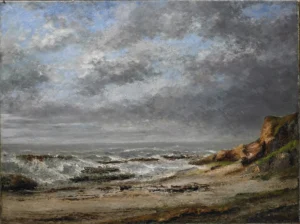Marine_ The Waterspout (1870)
Gustave Courbet's 'Marine: The Waterspout' captures the raw power and chaos of nature through a dramatic marine scene. Created in 1870, the oil on canvas showcases a formidable waterspout, characteristic of Courbet's Realist style. With dimensions of 27 1/8 x 39 1/4 inches, this artwork is a testament to his ability to convey emotional impact and movement in nature, making it a significant piece in art history.
Year 1870
About the Artwork
Created in 1870, 'Marine: The Waterspout' is a striking representation of Gustave Courbet's commitment to Realism and his fascination with the natural world. Courbet, a prominent figure of the 19th century, often focused on real-life subjects and the environment, capturing the essence of their reality. This painting, demonstrating his exceptional skill, shows a waterspout, a nature's spectacle that embodies both beauty and danger. It stands as a testament to Courbet's ability to convey the emotional weight of natural phenomena. The work is currently part of the collection at the Metropolitan Museum of Art in New York, where it continues to inspire viewers with its dynamic portrayal of the sea.
Did You Know
Gustave Courbet was known as a pioneer of the Realism movement, often emphasizing everyday life and natural subjects. He aimed to depict reality without idealization, which set the stage for future modern art movements.
Courbet’s fascination with the sea and natural disasters is evident in ‘Marine: The Waterspout.’ This artwork reflects not just a visual experience, but also the emotional intensity associated with nature’s uncontrollable forces.
‘Marine: The Waterspout’ has been influential in shaping the perception of marine art in the 19th century. Courbet’s emphasis on realism paved the way for artists to explore more dramatic and lifelike representations of nature in their works.










